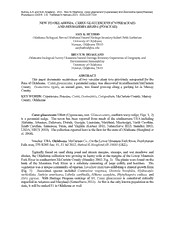
New to Oklahoma: Carex glaucescens (Cyperaceae) and Desmazeria rigida (Poaceae) PDF
Preview New to Oklahoma: Carex glaucescens (Cyperaceae) and Desmazeria rigida (Poaceae)
Desmazeha hgida (Poaceae). J NEW TO OKLAHOMA: CAREX GLAUCESCENS (CYPERACEAE) AND DESMAZERIA RIGIDA (POACEAE) AMYKBUTHOD Oklahoma Biological Survey/Oklahoma Natural Heritage Inventory/Robert Bebb Herbarium Oklahoma University of Norman, Oklahoma 73019 amybuthod@ou. edu BRUCE HOAGLAND W. Oklahoma Biological Survey/Oklahoma Natural Heritage Inventory/Department of Geography and Environmental Sustainability University of Oklahoma Norman, Oklahoma 73019 ABSTRACT This paper documents occurrences of two vascular plant taxa previously unreported for the flora of Oklahoma. Carex glaucescens, a perennial sedge, was discovered in southeastern McCurtain County. Desmazeria rigida, an annual grass, was found growing along a parking lot in Murray County. Catapodium, McCurtain County, Murray , Carex glaucescens Elliott (Cyperaceae, sect. Glaucescentes; southern waxy sedge; Figs. 1, 2) USA a perennial sedge. The taxon has been reported from much of the southeastern including is Alabama, Arkansas, Delaware, Florida, Georgia, Louisiana, Maryland, Mississippi, North Carolina, South Carolina, Tennessee, Texas, and Virginia (Kartesz 2011; NatureServe 2013; Standley 2002; USDA, NRCS 2013). The collection reported here is the first for the state of Oklahoma (Hoagland et 2004). al. Voucher: USA. Oklahoma. McCurtain Co.: On the Lower Mountain Fork River, Presbyterian & Falls area, T5S R26E Sec. 3 1, 3 1 Jul 2012, Buthod HoaglandAB- 10093 (OKL). Typically found on sand along pond and stream margins, swamps, and wet meadows and ditches, the Oklahoma collection was growing in loamy soils at the margins of the Lower Mountain Fork River in southeastern McCurtain County (Standley 2002; Fig. The plants were found on the 3). bank of the Mountain Fork River in a substrate consisting of large cobble and boulders. The vegetation was a unique community of riparian Taxodium distichum exhibiting a stunted growth form (Fig. 3). Associated species included Commelina virginica, Gratiola brevifolia, Hydrocotyle verticillata, Justicia americana, Lobelia cardinalis, Mikana scandens, Rhynchospora caduca, and Xyris jupicai. With Heritage Program rankings of SI, Carex glaucescens considered critically is imperiled in Arkansas and Maryland (NatureServe 2013). As this is the only knowrn population in the state, it will be mnked S 1 in Oklahoma as well. Buthod and Hoagland: Carex glaucescens and Desmazeria rigida new to Oklahoma Figure Pistillate spikes of Carex glaucescens. Photo by Bruce Hoagland. 1 . Buthod and Hoagland: Carex glaucescens and Desmazeria rigida new to Oklahoma Amy Figure Carex glaucescens Photo by Buthod. 2. . Buthod and Hoagland: Carex glaucescens and Desmazeria rigida new to Oklahoma Amy Figure Habitat of Carex glaucescens on the Lower Mountain Fork River. Photo by Buthod. 3. < glaucescens and Desmazeria rigida r\&N to Oklahoma 5 Desmazerm rigida (L.) Tutin (Poaceae, tribe Poeae: ferngrass; Fig. 4) is an annual grass from Europe found in disturbed sites. Synonyms include Catapodium rigidum (L.) C.E. Hubbard ex Dony, Poa rigida L., and Scleropoa rigida (L.) Griseb. Occurences are scattered throughout the USA, with New New New Alabama, California, Florida, Louisiana, Massachusetts, Mississippi, Jersey, Mexico, York, Oregon, Rhode Island, South Carolina, South Dakota, Texas, Washington, and Wisconsin USDA NRCS reporting its presence (Kartesz 2011; Tucker 2007: 2013), This report is the first for the state of Oklahoma (Hoagland et al. 2004). W Hwy Voucher: USA. Oklahoma. Murray Co.: 3.3 mi of 177 at Lake of the Arbuckles via & Buckhorn Road, T1S R3E Sec. 29, 28 Mar 2012, Buthod Hoagland AB- 10115 (OKL). The Oklahoma collection was found in disturbed, sandy-gravelly soils at the margin of a paved parking lot. Associated species included Poa annua and Arenaria serpyllifolia. Approximately 100 plants were present at the site. LITERATURE CITED Hoagland B.W, AK. Buthod, I.H. Butler, P.H.C. Crawford, AH. Udasi, W.J. Elisens, and RJ. Tyrl. 2004. Oklahoma Vascular Plants Database. Oklahoma Biological Survey, Norman, Oklahoma, <http://www.oklahomaplantdatabase.org Accessed 15 Jan 2013. Oklahoma Biological Survey, Univ. of Oklahoma, Norman. Kartesz, J.T 2011. The Biota of North America Program (BONAP), North American Plant Atlas. Chapel Hill, North Carolina <http://www.bonap.org/MapSwitchboard.html> Accessed 15 Jan 2013. An NatureServe. 2013. NatureServe Explore!': online encyclopedia of life, Version 7. 1. NatureServe, Arlington, Virginia, <http://www.natureserve.org/explorer> Accessed 15 Jan 2013. L.A Standley, 2002. Carex section Glaucescentes. Pp. 254-572, in Flora of North America New Editorial Committee (eds.). Flora of North America North of Mexico. York and Pp. 159, 415, 526, in M.E. Barkworth, L.K. Anderton, K.M. Capels, , S. Long, and M.B. Piep (eds.). Manual of Grasses for North America. Intermountain Herbarium and Utah State Univ. Press, Logan. USDA, NRCS. 2013. The PLANTS Database. National Plant Data Team, Greensboro, North Carolina, <http://plants.usda.gov> Accessed 15 Jan 2013.
